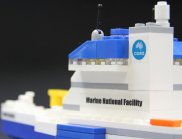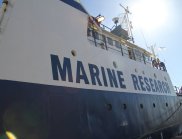Queensland’s national ship-naming competition winner to tour Australia’s Marine National Facility
The Federal Minister for Science deemed Clare Cameron’s entry, The Flinders Investigator, the joint winner as it linked the planned A$120 million research vessel to Australia’s maritime history – Matthew Flinders first circumnavigated the continent in His Majesty’s sloop Investigator.
The new state-of-the-art 93.9 metre vessel has been named Investigator and is under construction.
The new state-of-the-art 93.9 metre vessel has been named Investigator and is under construction. The vessel will herald a new era in marine and atmospheric research for Australian scientists when it arrives in late 2013.
The new Investigator provides a huge leap forward in capability, being equipped to accommodate 40 scientists and travel for up to 60 days at sea compared with the current research vessel’s, Southern Surveyor, capacity of 15 scientists and 28 days at sea.
Clare Cameron and her family, who live in Runaway Bay, have been invited to tour the Southern Surveyor while the vessel is in Brisbane for a short port period prior to its next research voyage. Clare will meet the team of Australian and international scientists who will have returned from their research voyage in the Coral Sea.
The Chief Scientist onboard, Dr Maria Seton from the School of Geosciences at the University of Sydney, and her team have been working in a little explored region between the Solomon Islands, Vanuatu, and New Caledonia taking rock samples from the ridges and plateaus at depths of up to 3.5 km. They also have mapped about 8000 kilometres of seafloor under their voyage track and taken gravity and magnetic data.
“These data will help us to better understand the type of crust that underlies the region and the age of these basins and will give us a more complete geologic and tectonic history of the area during the last one hundred million years,” Dr Maria Seton said.
“We are trying to understand what’s going on with the Earth’s crust in this part of the world by mapping what we call ‘hot spots’, which are a series of extinct underwater volcanoes and this fundamental research helps us to determine how the Australian continent has moved.”
“We believe on this voyage we may have found remnants of the Australian continent which would have splintered from mainland Australia when eastern Gondwana starting breaking apart. It will be at least a year before our hypotheses can be confirmed.”
Dr Seton and her team will explain some of their findings to Clare and her family and show them rock samples taken from the deep seafloor, kilometres below the surface.
Media resources
Click image for high resolution version


